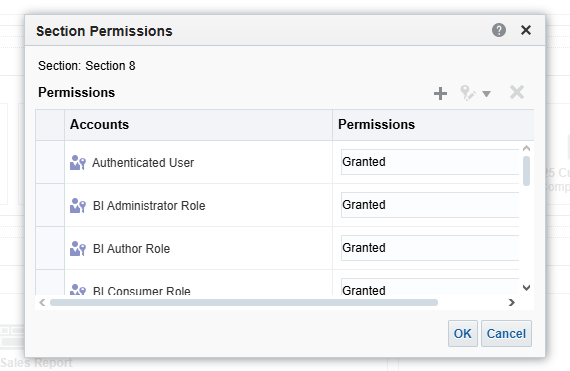Categories
- All Categories
- Oracle Analytics Learning Hub
- 31 Oracle Analytics Sharing Center
- 21 Oracle Analytics Lounge
- 251 Oracle Analytics News
- 45 Oracle Analytics Videos
- 16.1K Oracle Analytics Forums
- 6.3K Oracle Analytics Idea Labs
- Oracle Analytics User Groups
- 93 Oracle Analytics Trainings
- 16 Oracle Analytics and AI Challenge
- Find Partners
- For Partners
About runcat command and dashboard section object
Hi,
I am trying to use runcat command to monitor and control user permissions of catalog objects such as dashboards and analysis . But we've come up with a problem that we are unable to print out objects under dashboards such as 'section' object . I am adding some images to about the object we need help with.
We are using OAS 7 but might consider to downgrade or upgrade to any other version . Is there keyword for runcat command to print out this object, or any workaround we can try? Or can we submit a request to develop some help with the topic ?Thanks in advance.
Answers
-
Hi,
Welcome to the Oracle Analytics community and forum.Everything is written in the dashboard page itself. As said as reply to your idea,
runcatworks at the catalog object level. What is the catalog object in this situation? The dashboard page.The section inside the page is not a catalog object, therefore it isn't a thing for
runcat, because the tool work at a higher level, the dashboard page itself.Your section only exists inside the code of the page, and the ACL of the section is also in full text in the code of the page.
You can easily get all that by reading the XML of your dashboard pages, detecting sections and check if they do have an ACL element. If not, then the section has the same ACL as the dashboard page, which can be found by
runcat.If the section has an ACL element, then that's your ACL.
But
runcatcan't, and shouldn't, return the section as an object, because it isn't a catalog object. Butruncatcan return the XML of the dashboard page. Therefore it's just a simple look into the XML, something that any language will easily allow to do.By the way, OAS 7.0 is the 2023 release, it's out of standard support. You should upgrade to OAS 8.2 (2025) or OAS 7.6 (2024) to be on a supported version. But this isn't going to change anything in how
runcatwork (and also previous versions aren't going to change anything).You posted an idea before to even get a reply here. Knowing that
runcatworks as designed, as it should, you maybe wanted to post an idea to get a full ACL audit via a webservice of some kind.2 -
I think it is known limitation with runcat. You might need to dump everything to XML and use python to extract, again not sure. Best of luck!
0




